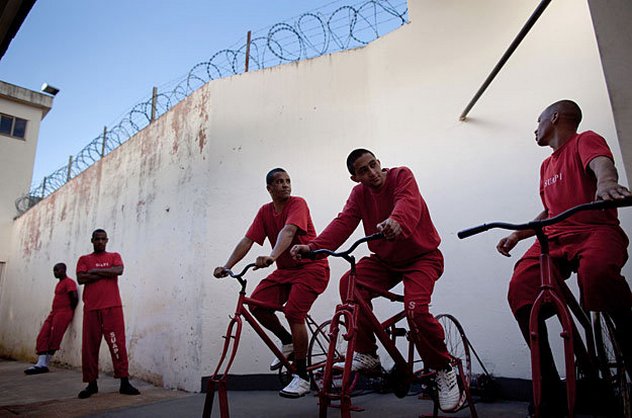 Crime
Crime  Crime
Crime  Movies and TV
Movies and TV 10 Wildly Different Movie Takes on Nuclear War
 Creepy
Creepy 10 Places Where Folklore Is Alive and Well
 History
History 10 Events That Unexpectedly Changed American Life
 Pop Culture
Pop Culture 10 Cases of Grabbing Defeat from the Jaws of Victory
 History
History 10 Common Misconceptions About the Renaissance
 Weird Stuff
Weird Stuff 10 Crazy Things Resulting from Hidden Contract Provisions
 Facts
Facts 10 Unusual Facts About Calories
 Weird Stuff
Weird Stuff 10 Days of Humiliation When the Person Should Have Stayed in Bed
 Humans
Humans 10 Surprising Ways Game Theory Rules Your Daily Life
 Crime
Crime 10 Truly Evil People Who Used Halloween as the Perfect Cover
 Movies and TV
Movies and TV 10 Wildly Different Movie Takes on Nuclear War
 Creepy
Creepy 10 Places Where Folklore Is Alive and Well
Who's Behind Listverse?

Jamie Frater
Head Editor
Jamie founded Listverse due to an insatiable desire to share fascinating, obscure, and bizarre facts. He has been a guest speaker on numerous national radio and television stations and is a five time published author.
More About Us History
History 10 Events That Unexpectedly Changed American Life
 Pop Culture
Pop Culture 10 Cases of Grabbing Defeat from the Jaws of Victory
 History
History 10 Common Misconceptions About the Renaissance
 Weird Stuff
Weird Stuff 10 Crazy Things Resulting from Hidden Contract Provisions
 Facts
Facts 10 Unusual Facts About Calories
 Weird Stuff
Weird Stuff 10 Days of Humiliation When the Person Should Have Stayed in Bed
 Humans
Humans 10 Surprising Ways Game Theory Rules Your Daily Life
10 Unconventional Ways To Rehabilitate Prisoners
In the United States, 67.8 percent of prisoners released in 2005 were rearrested within three years. Within five years, 76.6 percent of freed prisoners were once again behind bars. Even more surprising is that 56.7 percent were already back in jail within a single year of their release.
One may ask, “Why am I paying taxes just so the government can give prisoners more comfort?” Another may believe that we need to be more humane in the treatment of such prisoners. This article won’t try to convince anyone to change their views on the penal system. It simply aims to point out that every offender—whether a thief or a drug dealer, an abusive parent or a murderer—deserves even the smallest chance at redemption.
Correctional facilities from various nations have offered that chance through unconventional ways of rehabilitating inmates. It is up to the inmates themselves to take that chance if they wish to change their ways for good.
10Record Contracts
Carandiru Prison

On October 2, 1992, Carandiru Prison in Sao Paulo, Brazil became the site of a gruesome massacre. The prison, housing twice the number of inmates it was intended for, saw a rivalry between gangs erupt into a full-blown brawl. The brawl turned into a riot, the riot into an uprising, and soon around 300 police officers raided the complex. Within 30 minutes, they had killed 111 inmates, most of whom had been shot while hiding in their cells or surrendering on their knees.
The incident is forever etched in the ruins of the facility, which was demolished in 2002. However, in the intermediary years, Carandiru was turned into a kind of factory for young rap bands. There were allegedly dozens of groups in the facility, two of which—The Rap Prisoners and 509-E—actually have record contracts.
Rap music became a way for the inmates (those who survived the massacre and newer ones) to channel their aggression. The groups, naturally accompanied by police, were allowed to appear on talk shows to promote their material, and they have even had some live performances. Of course, they had to be back in their cells by 10:00 PM.
9A Forced Monastery
Eastern State Penitentiary

Nowadays, inmates no longer dwell in the recesses of the Eastern State Penitentiary in Philadelphia. Its new occupants seem to be spirits and otherworldly beings. It became a tourist attraction for ghost hunters and thrill seekers. Its most notable inmates included Al Capone and “Slick” Willie Sutton, who escaped the prison but was recaptured the same day.
Many years before that, an idea was devised by the Philadelphia Society for Alleviating the Miseries of Public Prisons, a group whose members included Benjamin Franklin at one point: Eastern State Penitentiary would give true meaning to the word “penitentiary.” The facility opened on October 25, 1829 as “a prison designed to create genuine regret and penitence in the criminal’s heart.”
In its heyday, the prison was immensely beautiful and had a “church-like” quality to it. Illuminated by a thousand skylights, it was “a forced monastery, a machine for reform.” Inmates lived in complete solitude, and a small opening in the ceiling of their cell would slide open each night. Facilitators believed that the eerie moment when the prisoners were bathed in moonlight from this “Eye of God” window, and the relative silence and solitude during their entire captivity, would make them realize the ugliness of their crimes and lead them to become genuinely penitent.
Not everyone agreed with the practice of holding prisoners in forced isolation, however. Charles Dickens once said: “I hold this slow and daily tampering with the mysteries of the brain to be immeasurably worse than any torture of the body; and because its ghastly signs and tokens are not so palpable to the eye . . . and it extorts few cries that human ears can hear; therefore I the more denounce it, as a secret punishment in which slumbering humanity is not roused up to stay.”
8Talent Shows
Putnamville Correctional Facility
The Putnamville Correctional Facility , a medium-security prison in Indiana, aimed to help in the rehabilitation of prisoners. With this in mind, they organized an event that’s similar to popular primetime US shows. The idea came to be known as “Inmates Got Talent,” where around 20 inmates performed in front of other prisoners.
Performances ranged from stand-up comedy to singing and even poetry. The co-creators of Project Redemption: Inmates Got Talent made the documentary while staying with the inmates and getting to know them for eight days. Apart from prisoners, several comedians including Michael “Big Mike” Mitchell (who was a former inmate himself) joined in on the act.
Facilitators were quite happy with the results, reporting that prisoners were thrilled to showcase their skills and talents and wanted to pursue careers in entertainment to have crime-free lives.
7Choreographed Dances
CPDRC
Not into stand-up comedy or singing? How about dancing? Choreographed dancing with hundreds and even thousands of prisoners swaying, swinging, and shaking their booties to the tune of the most popular music hits of past decades?
The Cebu Provincial Detention and Rehabilitation Center in the Philippines created a media and Internet sensation with the “CPDRC Dancing Inmates.” As part of their rehabilitation program, a multitude of inmates performed choreographed routines such as “Thriller,” “Greased Lightning,” and a “Queen Medley.” All of these performances were made available on YouTube.
Unfortunately, in 2010, after allegations of corruption and mismanagement of donations by the directors and facility heads, public release of these videos was put on hold, though the program still continued. Due to insistent public demand, the inmates were allowed to perform one more time for YouTube viewers, this time dancing to Psy’s massive hit “Gangnam Style.”
The story of the CPDRC Dancing Inmates was so inspirational and downright hilarious that it led to a movie titled Dance of the Steelbars, with real actors dancing in prison garb.
6Art Galleries And Shakespeare’s Plays
San Quentin State Prison
Stand-up comedy is one thing. Choreographed dance moves are another . . . but what about the visual and dramatic arts? Painting is one of the best ways to provide a window to one’s soul. Vivid colors splashed on a canvas highlight the mood not only of the artist, but of the times as well.
In San Quentin State Prison, the oldest and best-known correctional institution in California, discipline in the arts has led to discipline of the self, even among its most ruthless inmates. Clinton Duffy, the prison warden from 1940–1952, abhorred capital punishment and instead preferred rehabilitation methods. To this end, he introduced night schooling for inmates and even got them interested in journalism and broadcasting by allowing them to publish a newspaper and operate a radio station.
Today, San Quentin takes part in the Prison Arts Project, where inmates can hone their talents at drawing, acrylic painting, block printing, and even calligraphy. Prisoners who join the program have their work showcased at the local art gallery in San Francisco.
The prison also offers the chance for prisoners to engage in theatrical renditions of Shakespeare’s most vaunted works. Through the Marin Shakespeare Company, inmates have come up on stage to perform works such as Much Ado About Nothing, The Merchant of Venice, and Hamlet. Despite budget cuts, the program has managed to survive due to the contributions of private foundations. Perhaps there’s nothing more profound than seeing a convicted killer shout “Murder! Murder most foul!” Then again, it’s worth noting that both programs for the visual and dramatic arts are a means for the inmates to express themselves, be honest and open, and to find peace.
5Power Generation And Literacy Training
Santa Rita do Sapucai Prison

Another story pertaining to a Brazilian correctional facility is that of the Santa Rita do Sapucai Prison, which happens to be near Sao Paulo as well. Jose Henrique Mallmann, a local judge, decided to have the inmates contribute to society while imprisoned, in a form of “poetic justice.”
Mallmann heard of stories about gyms in America that were partially powered by patrons of the establishment. The bikes in those gyms were attached to generators. Each time someone pedaled, the generators produced electricity that offset the energy use of the entire club. It’s clean, efficient, and healthy. Mallmann introduced the same concept to the town’s jail and added another incentive—volunteers shave one day off their sentence for every three eight-hour shifts spent on the bikes. One day’s worth of biking, one day off your stay in prison. An inmate has reportedly reduced his sentence by 20 days and his weight by 4 kilograms (9 lb). How does “poetic justice” apply? Well, the inmates power the lamps in the town’s plaza, thereby providing a sense of security for the villagers.
Another similar concept introduced in the country is the “Redemption Through Reading” program, wherein inmates can reduce their sentences by up to 48 days per year. How? By reading literary classics and scientific tomes. To prove they’ve done their homework, they’re required to write a book report. Both programs aim to reduce the number of inmates in Brazil’s overcrowded prisons, which, in December 2011, were at 167 percent capacity.
4Extensive Service To The Community
Berrimah Prison

California state prisons have so-called Conservation (or “Fire”) Camps. Multiple groups of up to 4,000 inmates are volunteers of the program. It was designed so that the inmates would be able to respond to statewide assignments, from simple construction efforts to grave emergencies such as floods and fires. Inmates from various prisons across the state are actually some of the first crews on the scene at devastating wildfires.
Across the Pacific, service to the community has also become more extensive. In Berrimah Prison in Darwin, Australia, the Attorney General implemented a radical new scheme to rehabilitate prisoners and reduce recidivism, known as “Sentenced to a job.” Inmates are assigned to various tasks around the county, and for their work they receive a certain salary. In turn, this allows them to pay for the rent . . . of their own cells. They also pay 5 percent of their salary to an assistance fund for crime victims. In essence, the community has turned prisoners into public servants.
Low-level offenders are allowed to leave the prison, unsupervised, and ride a bus around town to their workplace—and the bus driver happens to be a fellow inmate as well! They’re all expected to come back to prison and report for the 7:00 PM headcount. Sadly, boys will be boys, and on one occasion some prisoners have busted out while on work duty. Don’t worry, they still returned—apparently they just needed to get some cell phones, liquor, and a certain “green, leafy substance.” Oh, those Aussies.
3Lovable Pets
Various Facilities

Animals have provided us with companionship throughout human evolution. It’s hard to take away that innate bond. Several programs aim to focus on this bond in hopes that men who are shunned by society can instead form a companionship with a beast that is wild, untamed, and unfit for adoption.
“Cuddly Catz” facilitates a program wherein felines initially deemed unadoptable or undesirable are matched with prisoners at the Larch Corrections Center in Washington. Inmates care for the cute furballs. Once the cats have become more sociable, they move on to families willing to take them in, while new pets take their place.
Similarly, “Puppies Behind Bars” is a program at the New York Bedford Hills Correctional Facility for Women (a maximum security prison). Originally, the puppies were supposed to be trained as guide dogs, but after 9/11, they also started to get trained for explosives detection.
The “K-9 Companion Program” in Colorado has produced a remarkable story. Christopher Vogt, convicted of murder in 1995, was one of the first inmates who volunteered to train dogs rescued from pounds. These canines lived and were cared for by the inmates and were also trained to help paralyzed or blind people. One of Vogt’s “graduates” was Clyde, a Labrador trained to provide companionship for the mentally disabled. Clyde eventually found a home with the Tuckers, whose son Zach suffered from Asperger’s syndrome. Zach had avoided contact with his parents for several years prior to meeting Clyde. Since then, Zach’s become more open to his parents and even made a lot of friends. As for Christopher Vogt, he’s still behind bars, but he’s managed to write two children’s books about how dogs can help kids with autism.
2Vipassana Meditation
India
Vipassana, a meditative act that means “to see things as they really are,” has been taught in India for more than 2,500 years. It was a means for practitioners to improve self-awareness, focus solely on the present, and cure themselves of negativity in general. The practice of Vipassana meditation as a correctional tool is a recent development. First attempted in the jails of Jaipur in 1975, Vipassana proved to be a successful, if strenuous, task. It was only in November 1993 that its usage as a means of rehabilitating prisoners became even more pronounced.
In Tihar Jail, maximum security prison in New Delhi, a female police administrator by the name of Kiran Bedi introduced Vipassana courses. Prison staff and a handful of inmates were invited to a retreat to practice the techniques. By next year, the number of inmates taking up meditation classes increased to over 1,000. Tihar Jail even had one of its cellblocks designated as a permanent meditation center.
This method has also gained popularity abroad. In November 1997, the first ever US Vipassana courses were held in the North Rehabilitation Facility in Seattle. The next year, courses were offered in Lancaster Prison in England, and the year after that, in the Te Ihi Tu Trust facility in New Zealand. An overwhelming number of those who participated in the program reported noticeable improvements in curing depression, anger management issues, and even sleeping problems. They have also come to realize their regrets for past transgressions and their desires to live fuller, happier, crime-free lives. If you’re ever interested in learning more about Vipassana, you don’t need to go to prison—you can simply watch the above video.
1Relative Freedom
Iwahig Prison And Penal Farm
Those who experience relative zen in their lives may consider prison simply as a state of mind. That may also be the case for those living in the Iwahig Prison and Penal Farm, situated on over 45,000 hectares of land in Palawan, one of the many islands in the Philippines. Palawan itself has a long history rooted in the penal system. For instance, during the Spanish Era, the island became the site to which criminals were banished and exiled.
During the American period of occupation, Iwahig became a successful colony after several reforms were enacted. Prisoners were given vocational training in farming, fishing, forestry, carpentry, and paramedical services. Iwahig is referred to as a “Prison Without Walls,” for there are none. Those who reside there are free to roam around and do what they want. They are allowed to police themselves to a certain degree, each living a simple life in the province without want.
They provide for themselves, or rather nature provides for them. The prisoners’ harvest depends on their own efforts. Their families are allowed to move in with them, and instead of plotting petty crimes, they plan on what to catch and cook. Despite having no fences or cells, there have been relatively few escape attempts. In many cases, the escapees had simply missed their loved ones (who had opted not to visit or move in with them). Most of the men at Iwahig are not petty criminals, either; many of them are murderers.
Jo plans to try out Vipassana meditation someday—he’s got a bad back due to writing while hunched, poor guy. What do you think about the list or about rehabilitation programs in general? Let him know at [email protected], or in the comments section.








